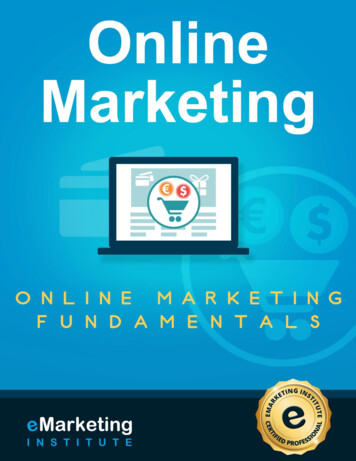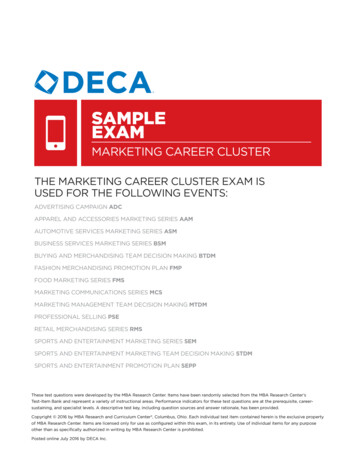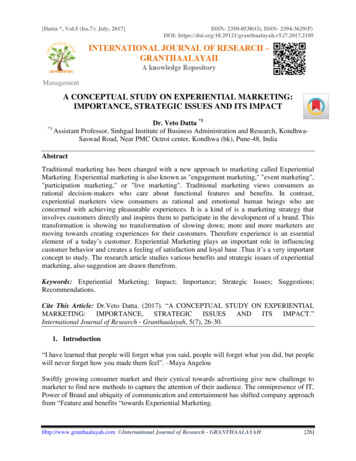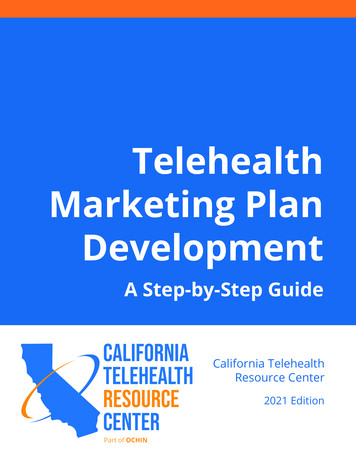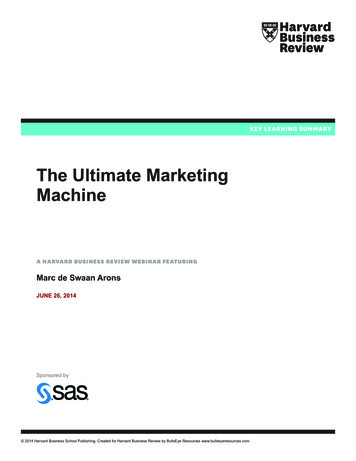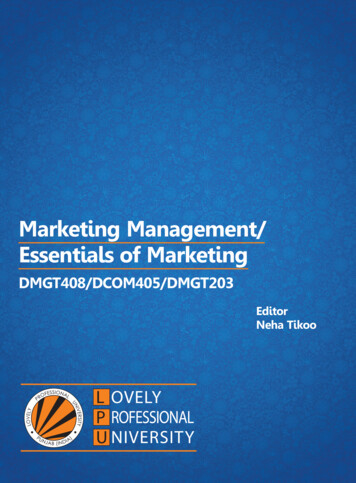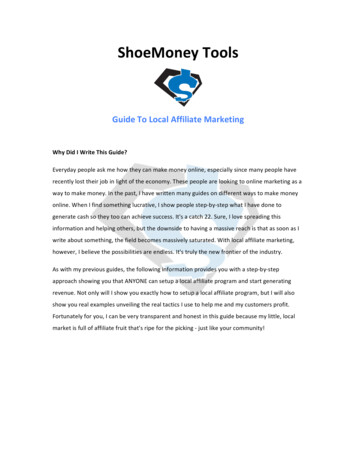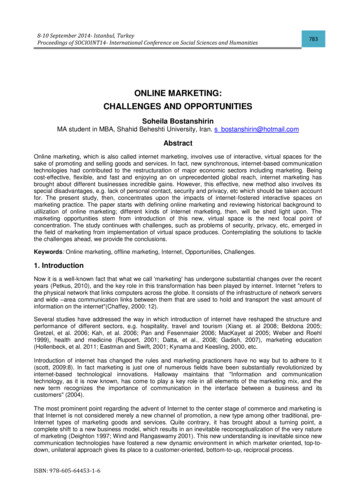
Transcription
8-10 September 2014- Istanbul, TurkeyProceedings of SOCIOINT14- International Conference on Social Sciences and Humanities783ONLINE MARKETING:CHALLENGES AND OPPORTUNITIESSoheila BostanshirinMA student in MBA, Shahid Beheshti University, Iran. s bostanshirin@hotmail.comAbstractOnline marketing, which is also called internet marketing, involves use of interactive, virtual spaces for thesake of promoting and selling goods and services. In fact, new synchronous, internet-based communicationtechnologies had contributed to the restructuration of major economic sectors including marketing. Beingcost-effective, flexible, and fast and enjoying an on unprecedented global reach, internet marketing hasbrought about different businesses incredible gains. However, this effective, new method also involves itsspecial disadvantages, e.g. lack of personal contact, security and privacy, etc which should be taken accountfor. The present study, then, concentrates upon the impacts of internet-fostered interactive spaces onmarketing practice. The paper starts with defining online marketing and reviewing historical background toutilization of online marketing; different kinds of internet marketing, then, will be shed light upon. Themarketing opportunities stem from introduction of this new, virtual space is the next focal point ofconcentration. The study continues with challenges, such as problems of security, privacy, etc, emerged inthe field of marketing from implementation of virtual space produces. Contemplating the solutions to tacklethe challenges ahead, we provide the conclusions.Keywords: Online marketing, offline marketing, Internet, Opportunities, Challenges.1. IntroductionNow it is a well-known fact that what we call 'marketing' has undergone substantial changes over the recentyears (Petkus, 2010), and the key role in this transformation has been played by internet. Internet "refers tothe physical network that links computers across the globe. It consists of the infrastructure of network serversand wide –area communication links between them that are used to hold and transport the vast amount ofinformation on the internet"(Chaffey, 2000: 12).Several studies have addressed the way in which introduction of internet have reshaped the structure andperformance of different sectors, e.g. hospitality, travel and tourism (Xiang et. al 2008; Beldona 2005;Gretzel, et al. 2006; Kah, et al. 2006; Pan and Fesenmaier 2006; MacKayet al 2005; Weber and Roehl1999), health and medicine (Rupoert, 2001; Datta, et al., 2008; Gadish, 2007), marketing education(Hollenbeck, et al. 2011; Eastman and Swift, 2001; Kynama and Keesling, 2000, etc.Introduction of internet has changed the rules and marketing practioners have no way but to adhere to it(scott, 2009:8). In fact marketing is just one of numerous fields have been substantially revolutionized byinternet-based technological innovations. Halloway maintains that "Information and communicationtechnology, as it is now known, has come to play a key role in all elements of the marketing mix, and thenew term recognizes the importance of communication in the interface between a business and itscustomers" (2004).The most prominent point regarding the advent of Internet to the center stage of commerce and marketing isthat Internet is not considered merely a new channel of promotion, a new type among other traditional, preInternet types of marketing goods and services. Quite contrary, it has brought about a turning point, acomplete shift to a new business model, which results in an inevitable reconceptualization of the very natureof marketing (Deighton 1997; Wind and Rangaswamy 2001). This new understanding is inevitable since newcommunication technologies have fostered a new dynamic environment in which marketer oriented, top-todown, unilateral approach gives its place to a customer-oriented, bottom-to-up, reciprocal process.ISBN: 978-605-64453-1-6
8-10 September 2014- Istanbul, TurkeyProceedings of SOCIOINT14- International Conference on Social Sciences and Humanities7842. What is online marketing?Chaffey et al. (2000) simply define internet marketing as "the application of the internet and related digitaltechnologies to achieve marketing objectives"(12). This definition is a simple definition which, unlike thefollowing ones, does not touch the important aspect of customer relationship. According to (Kotler &Armstrong, 2012: 508; Kotler et al., 2010: 493) Online marketing consists of measures and activities topromote products and services and build relationships with customers over the Internet. Burrett (2008)understands online marketing as ―carefully targeting users and getting them to interact with you while they‘reengaged with the most personal, intimate medium ever invented‖ (44). The most comprehensive definitionhas been articulated by Chaffey (2007), he defines online marketing as ―Applying Digital technologies whichform online channels (Web, e-mail, databases, plus mobile/wireless & digital TV) to contribute to marketingactivities aimed at achieving profitable acquisition and retention of customers (within a multi-channel buyingprocess and customer lifecycle) through improving our customer knowledge (of their profiles, behavior, valueand loyalty drivers), then delivering integrated targeted communications and online services that match theirindividual needs". As this relationship concept definitions show online marketing revolve around interactionand building relationship with customers, a point which discriminates it from traditional, offline marketing.3. Historic BackgroundInternet has its origins in cold war and technological rivalry between USSR and US. In fact "while the WorldWide Web was created in 1991, its origin dates back to 1957 when the Soviet Union launched the Sputnik Isatellite" (Dickey and Lewis, 2011: 2). US reacted with establishment a department of Defense AdvancedResearch Project Agency (DARPA) which launched in 1960s ARPANET, an experimental project ofcomputer networks from which what we now know as internet developed. Since then internet contributed toscience incredibly and "by the late 1980s the internet was being used by many government and educationalinstitutions" (Ferguson, 2008: 69).So internet was considered an inclusive communicative tool of scientific and research centers for severalyears and its academic function was its dominant prior to discovering its commercial capabilities which led toits commercialization. As Oksana (2007) puts it: "until the mid-nineties, the research and academiccommunities accounted for most of the internet population but the commercialization of internet soon gainedenormous momentum and the business community quickly became aware of the potential it has to offer"(47).With increasing the number of internet users during the 1990s, entrepreneurs started to appreciatecommercial prospects of this new medium. Although there is no complete consensus on when did internetmarketing exactly start, but the majority of commentators refer to 1994. So it is widely held that "significantcommercial use of the Internet began with the first ‗banner ads‘ on web pages in 1994, and the appearanceof Internet-based ‗malls‘ (the electronic equivalent of a storefront) such as Amazon.com in 1995".Statistics make it clear that this young marketplace, online marketing, has had an astonishing rate of growth.So amazing is the growth rate of this new paradigm of marketing that it is hard to believe how young it is. Infact "in 1994, spending for internet marketing totaled nearly nothing, but increased to over 300 million in1995. After a decade later, marketing spending and internet marketing business has exploded to nearly 500billion (according to Forrester Research). Today, it‘s hard to believe in having an organization which doesn‘thave some kind of online presence." (Shirvastav and Alam, 2014: 25)This brief historic background is concluded by pointing to the fact that step by step online marketing hasbecame a much more sophisticated practice. So early methods of internet marketing such as onlineadvertising and email marketing has been followed by more younger, developed methods such as searchengine optimization or social media marketing.4. Different methods of online marketingOnline marketing which is also called internet marketing and e-marketing includes several methods andtechniques which are introduced briefly as follows:Online AdvertisingThe most known technique of online marketing is online advertising. In this method virtual space is used toput marketing messages on websites to attract internet users. Just similar to methods offline marketing andother types of online marketing, the major objective of online advertising is to increase sales and build brandISBN: 978-605-64453-1-6
8-10 September 2014- Istanbul, TurkeyProceedings of SOCIOINT14- International Conference on Social Sciences and Humanities785awareness. Online advertising involves using of internet for displaying promotional messages on thecomputer screens (Duguay, 2012) and refers to "deliberate messages placed on third-party websites .search engines and directories available through Internet access" (Ha, 2008: 31).Online advertising similar to TV ads uses the element of interruption. But it uses it in a much more creative.Contrary to TV advertisement, online advertisement do not force the recipient to pay attention to thepromotional peace, but it tries to persuade or attract s/he to do so, because instead of coming in intervals itis placed along or among other non-marketing contents. The now empowered internet recipient still has thepower to ignore the advertisement and it is totally up to her/him to click or not.Online advertising, sometimes called display advertising, uses different methods to display a marketingmessage online. Needless to say that with the progress of technology, new ways of practicing the art ofonline advertisement is developed. In addition to images, pictures, logos etc, other different methods nowused in this field including interstitial banners, pop-ups and pop-unders, map adverts, floating advert,banner advert (stokes, 2009: 30).Email-marketingE-mail marketing, using e-mail for sending promotional messages to internet users, has been consideredone of the more effective methods of online marketing. Several researchers have shed light upon privilegesof conducting online marketing this way (Wreden, 1999; Jackson & DeCormier, 1999; Raad et al., 2010; Nial,2000). In this regard Peppers and Rodgers (2000) among its benefits point to "high response rates" and"low costs" of email marketing and believe that this advantages "are rapidly turning email marketing into aninvaluable tool"(4).Despite these benefits email marketing suffers from deficiencies. One these problems are that onlinecustomers can easily ignore the received advertisements and even some email clients would decide to putthem in the spam folder. So some measures should be taken to overcome the possibility of ignoringpromotional emails on the part of customers. One of the solutions is to not solely rely on email marketing.Marketers should employ different channels and methods of marketing to increase the chance of success.Another measure to transcend problems of email-marketing is permission email marketing. "Permissionmarketing" has been coined by Godin (1999). In this method recipients are asked for their permission toreceive marketing messages from the commercial marketers. So unless the recipients have not expressedtheir consent, they will not send commercial emails.Search Engine Optimization (SEP)Nowadays it is hardly possible to imagine a business which has not its own website. But having a welldesigned website does not necessary result in an ideal amount of visits. In order for this goal to beaccomplished another type of online marketing, called SEM و should be adopted.In fact, one of major methods of conducting online marketing is search engine optimization, which is alsocalled search engine marketing. Davis (2006) defines it in this way: "SEO - short for Search EngineOptimization - is the art, craft, and science of driving web traffic to web sites web traffic is food, drink, andoxygen – in short, life itself – to any web-based business" (2). Parikh and Deshmukh (2013) also offer thisdefinition: " Search engine optimization can be described as a cluster of strategies and techniques used toincrease the amount of visitors to a website by obtaining a high-ranking placement in the search results pageof a search engine (SERP)" (1).The importance of search engine optimization lies in the fact that customers most of the time use engines asa major gate to get around in the internet. So some marketing techniques have been developed to enhancethe rank of intended business websites in the search engine results. The purpose of SEO strategies is toplace a given website among highly listed entries returned by search engines which in its turn producesmore traffic. So, "Web site owners, webmasters and online marketers want search engines to send traffic totheir site. Therefore, they need to make sure that their sites are relevant and important in both the eyes ofthe search engines and the users." (Stokes, 2009:70)Affiliate marketingAffiliate marketing is a major component of package of online marketing methods and refers to the processISBN: 978-605-64453-1-6
8-10 September 2014- Istanbul, TurkeyProceedings of SOCIOINT14- International Conference on Social Sciences and Humanities786of gaining a commission by promoting products or services of another company. Also in this method two ormore website owners can build relationship to increase mutual financial benefits. With respect to itsdefinition, "affiliate marketing is simply defined as : A web-based marketing practice , often using automatedsystems or specialized software in which a business rewards their affiliate for each visitor, customer, or salewhich is brought about as a result of affiliate's marketing efforts. In most cases, the reward is monetary in theform of a monthly check. Most well-designed affiliate programs are easy to implement, require little or nosetup, are free, and can instantly generate a new source of revenue for you"(Brown, 2009:17).Affiliate marketing has been used in a number of businesses for promoting products and services offline. Butonline environment has extends the prospect of deploying this method dramatically. The reason is thatreferral or affiliates are very easy to track online. This system of marketing is widely used to promotewebsites and affiliates are compensated for their effort to attract every single "visitor, subscriber, orcustomer". These affiliates sometimes are considered to be "an extended sales force" at the service of awebsite. Because affiliates are rewarded based on their performance, affiliate marketing is also called"performance marketing" (stokes, 2009:46).Social Media MarketingSocial media has changed every aspect of our life dramatically. In fact it has become "the method ofstatement in the 21't century, enabling us to express our belief, ideas and manner in an absolute new way ".Beyond changing our way of conducting social life, social media provides world of marketing withunprecedented opportunities and "also have a huge impact on corporation, where they have realize thatwithout a correct plan and social media strategy they have no chance to stand out in the rapidly changingdigital freedom" (Saravanakumar and SuganthaLakshmi, 20012: 44).Social Media marketing, thus, has become increasingly a priority without taking which into considerationmarketing cannot realize its objectives. Social media especially is promising for small businesses becauseincreases their competitive edge. This new rewarding type of marketing, social media marketing, can beeasily defined as" a term used to describe the process of boosting website traffic, or brand awareness,through the use of social media networking sites most social media marketing programs usually revolvearound creating unique content that attracts attention and encourages the viewer to share it with their friendsand contacts on social networks. Your business message spreads from one user to another and impactswith the user in a stronger way because it appears to originate from a trusted source, as opposed to thebrand, business or company itself" (2014: 2).As is apparent from the above citation the key element of social media marketing is involving user of socialnetworks. If users / readers come across a right and relevant content the likelihood of sharing it with otherpeople in their social networks increases. So if a marketing body succeeds in making social media usersshare its promotional content with people in their network it that means that it has gained support from atrusted source and possibly will be regarded highly by the recipient. Clearly a promotional content shared bya close friend has much more impact than content directed from the part a marketing party. The impact ofcontents shared by social network members is high due to the fact they are originally kind of a "word ofmouth" circulating on the online environment.With respect to pillars of social media it should be noted that the "social media comes in many forms [such as] blogs, microblogs (Twitter), social networks (Facebook, Link), media-sharing sites (YouTube,Flickr), social bookmarking and voting sites (Digg, Redit), review sites (Yelp), forums, and virtual worlds(Second Life)" (Zarella, 2010: 3).Viral MarketingAnother method of conducting online marketing which overlaps remarkably with social media marketing, dueto centrality of "word of mouth" to it, is called Viral Marketing. Viral marketing, in fact, is "a form of word ofmouth marketing which aims to result in a message spreading exponentially. It takes its name from a virus,because of the similarities that marketers aim to emulate: It is easily passed on. The number of people whohave been ―infected‖ grows exponentially"(Stokes, 2009: 150)Viral marketing is a new concept which has been developed with the advent of Internet. Viral marketingspreads through social networks and it is a virtual version of word of mouth. It is a very cheap mode ofmarketing and if you use it there is no need to spent massive amounts of money on traditional expensiveISBN: 978-605-64453-1-6
8-10 September 2014- Istanbul, TurkeyProceedings of SOCIOINT14- International Conference on Social Sciences and Humanities787marketing campaigns. Viral marketing works through encouraging people to share, pass along, and forwarda marketing message; it is based on a high rate of pas-along form a user to another user. It is clear thatharnessing such a powerful instrument, word of mouth, and having others share your products and sell it,guarantees the success, even compared with launching a classical marketing campaign.Among other means of promotion and building brand awareness such as images, jokes, e-carts etc, viralmarketing campaigns employ creative digital videos as well. Digital videos are most useful according to Kirby(3006) due to following reasons: They are small enough to be passed from peer to peer via email after downloaded from multipledistribution websites, encouraging greater user-driven spread. They trackable after downloaded, as they are passed form user to user via email, so they areprovide brands with greater campaign accountability. There is a less risk of user interference with the agent. Video is familiar, ad-like/film-like format to users, with the added advantage of interactivity (digitalvideo files can include hotspots that enable users to link through the file to a web page) (94-95)5. Advantages of Online MarketingEmpowering effectOne of advantages of online marketing is related with its enabling effect especially on small businessessince "internet can extent market reach and operational efficiency of small and medium interprises(SMEs)"(Dholekia and Kshetri, 2004: 311). In fact internet creates a kind of democratized environment inwhich marketing has been restructured in such a way that even small businesses are given a good chanceto promote and brand their products on a much more larger scale (Jobber, 2001; Tapp, 2008). It should be,therefore, stressed that "internet has created unprecedented opportunities for small businesses to engage innational and international marketing campaigns which could have been unaffordable due to the huge amountof resources required" (Poon and Jevons, 1997: 29). Email marketing, bogging, launching web-sites, etc areamong easily affordable inter-fostered channels than can provide small business with the ability to surviveand compete.Elimination of geographic barriersOne of the key advantages of online marketing is that it removes all geographical limitation from the practiceof buying and selling. So internet allows an unlimited global reach (Allen and Fjermestad, 2001; Teo andTan, 2002; Sigala, 2008) at on outstandingly lower cost. Due to massive cost of traditional media, globalreach was once the exclusionary realm of huge multinational corporation, but the advent of cost-effectiveinternet technologies has enabled smaller businesses to enjoy this kind of reach. Overcoming thegeographic barriers, marketers are now able to present products and services to different groups ofcostumers across the universe with the simple condition that they have access to internet (Mohammed,2010: 2).24 hours / seven days availabilityInternet now can provide customers with timely information due to its availability 24 hours a day, 7 days aweek (Lane, 1996). So, due to the establishment of online shops, customers are now able to acquireinformation and shop online any time of day or night they wish and prefer. So there remain no timelimitations in this regard because online businesses have no special closing and opening times. People mayvisit physical markets after searching internet or the other way round they can surf internet for competitiveprices after visiting physical stores. (Sharma, 2011: 203). Besides that there is no doubt that online purchaseis more convenient since there is no need to go out of home, visiting different stores and take the burden ofcomparing different products and prices. The buyers can do their shopping much more effectively from thecomfort of their homes. Needless to say a lot of time and energy is saved this way.Cost-effectivityIt goes without saying that, compared with traditional advertising media channels, which are very resourceISBN: 978-605-64453-1-6
8-10 September 2014- Istanbul, TurkeyProceedings of SOCIOINT14- International Conference on Social Sciences and Humanities788consuming, online marketing via internet is clearly cost-effective and can accomplished its objectives at afraction of the cost (Paul, 1996; Hamil, 1997; Godes and Mayzlin, 2004; Sheth and Sharma, 2005; Buhalisand Law, 2008; Poon and Jevons, 2010). For instance it is obvious that the cost of launching an ad online isfar less than placing an ad in a magazine or on a billboard. The cost of establishing one's virtual presence,networking with other institutions and communication with consumers is significantly low. Consequentiallyinternet marketing enables the companies to save their resources, an aspect which is highly appreciated bycompanies since the online marketing campaigns don‘t require massive investment.TrackabilityAnother aspect of the online marketing is its possibility of tracking. In fact "the track-ability of InternetMarketing is one of its greatest assets" (2014). Internet enables measurement of everything taking place onit. So, the number of clicks that a particular promotional piece receives and amount of website traffic is easilymeasured. In this way the marketer is enabled to track the visitors to her/his website and understand theirbehavior. Internet also allows the companies to find out whether their campaigns are working or not, whatkind of customers are interested in their products, from where?The ability to track online customers increases dramatically due to the fact that "internet constitutes the mostaccountable media ever. Web site log software and real-time profiling track the number of users who vieweach page, location of previously visited pages, date of view, time of view, duration of viewing, links followed,and so on" (Granitz and Greene, 2003: 19).PersonalizationPersonalization which comes with customization is another important aspect peculiar to marketing onlinethrough internet. So online marketing is a personalized marketing which is also called marketing to theSegment of One or "one-to-one marketing" (Peppers and Rogers,1993). But what is personalization?Personalization refers to tailoring products and services to customers' preferences based on their online,registered purchase history. In fact "since electronic interaction with customers allows the gathering ofdetailed information on the needs of each individual customer, firms can automatically tailor products andservices to those individual needs" (Karavdic and Gregory, 2005:80). This process results in offeringcustomized products to customers. In this way customers are send personalized messages which producesmuch greater impact compared with impersonalized, generic messages send indiscriminately to mailbox ofcustomers.Personalization results in formation of sustainable relationship with customers; as Riecken (2000) puts it"personalization is about building customer loyalty by building a meaningful one-to-one relationship; byunderstanding the needs of each individual and helping satisfy a goal that efficiently and knowledgeablyaddresses each individual‘s need in a given context"(26). Based on metrics internet helps marketer togather, customer, for instance, can be greeted with targeted offers whenever they visit website. So with theaid of gathered data of customers preferences, the sites can be customizes for the target audience whichbrings about an increasing interaction and builds up a "sense of intimacy" between marketer and audience.This is especially important due the fact that traditional modes of marketing such as Mass media, TV, andnewspapers cannot be shaped by their users' needs, demands, inclinations, and preferences. Sopersonalization and customization is obviously considered a major advantage or opportunity of onlinemarketing via internet (Bhui and Ibrahim, 2013: 223)6. Challenges of Online MarketingProblem of integrityIntegrated marketing has been a central theme of the profession (Clown and Baak, 2013; Kitchen andBurgman, 2010; Blech and Blech, 2013). On the other hand one of major problems with marketingcampaigns is that they employ several offline and online promotions channels such as press, brochure,catalogue, TV, cell phone, e-mail, internet, social media etc, while lack a comprehensive, harmonizingmarketing framework. Each item is used in isolation and accomplished as a different task not as acomponent of an integrated campaign aimed at realization of specified and particular objectives. Thisdeficiency can be compensated for by taking a holistic approach which synchronizes different traditional andinternet age modes of marketing communication as moments of an integrated structure. With respect tovirtual, online component of an integrated marketing what is "also worth noting (or reminding) is that likeISBN: 978-605-64453-1-6
8-10 September 2014- Istanbul, TurkeyProceedings of SOCIOINT14- International Conference on Social Sciences and Humanities789offline marketing, all aspects of online marketing are inextricably linked- and in many cases interdependent.Therefore none of the element marketing should stand in isolation. The website will never be visited if thereare no links to it, viral marketing requires email or social media websites to communicate the message andsearch engines are useless without websites to link to it. So it is that in any internet marketing strategy allcomponents must dovetail together (Charlesworth, 2009:341).Lack of face-to-face contactLack of personal contact is another deficiency of online marketing which has been addressed in onlinemarketing research and literature (Goldsmith and Goldsmith, 2002; Phau and Poon, 2000). Internettransactions involve no embodied, personal interaction and that is why some customers consider electronicmodes of providing customer service impersonal and enjoy the experience of shopping in a bricks andmortar, physical store. They prefer to talk to store personnel in a face to face manner, touch the relatedproduct with their hands, and socialize with other customers. Virtual marketplace cannot provide for thisfunction of offline shopping and lacks personal interaction. To be more specific "for the types of productsthat rely heavily on building personal relationship between buyers and sellers such as the selling of lifeinsurance, and the type of products that requires physical examination, Internet marketing maybe lessappropriate" (Kiang and Chi, 2001:159).Face to face contacts is not important just in the case of special types of products; here culture is also arelevant variable. For example Rotchanakitumnuai & Speece (2003) can be referred who have highlightedthe lack of personal contact in online transactions. Among other things, they refer to Asian cultures in whichpersonal relationships are of a prominent value and that this, together with the transaction context, is oftenplays a crucial role in ensuring the success of financial deals.Security and PrivacyInformation privacy is among major topics to be taken into consideration in today‘s evolving electronic world.It is clear enough that nowadays customers' data can easily be shared with other companies without askingfor their permission. Moreover their more crucial personal data such as usernames and passwords are notimmune from hackers (Lantos, 2011: 74). Another related problem is spas and pop-up adds whichconsidered by majori
Online marketing, which is also called internet marketing, involves use of interactive, virtual spaces for the sake of promoting and selling goods and services. In fact, new synchronous, internet-based communication technologies had contributed to the restructura


